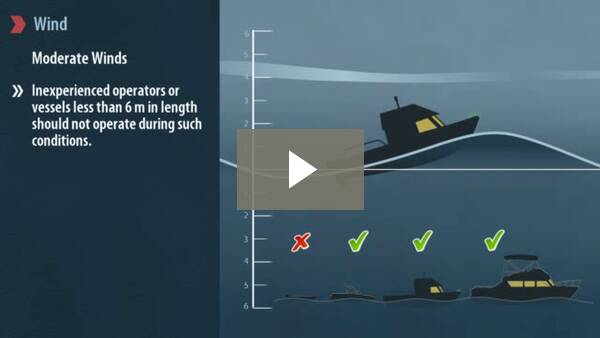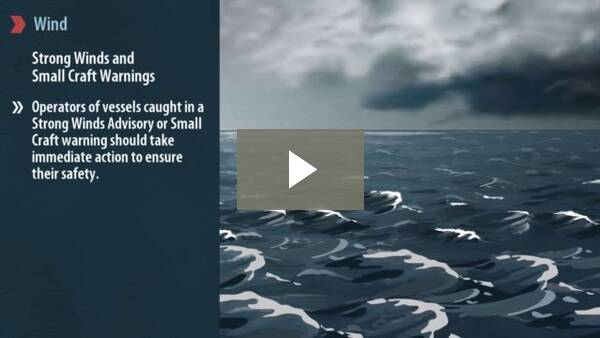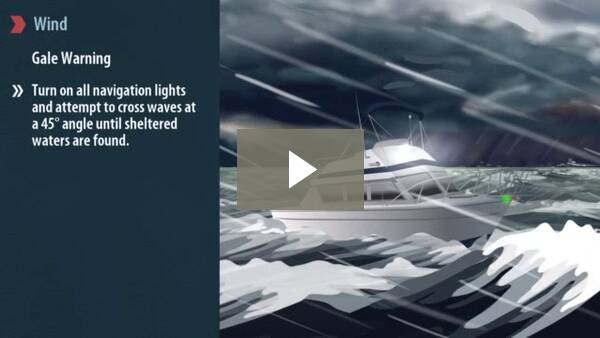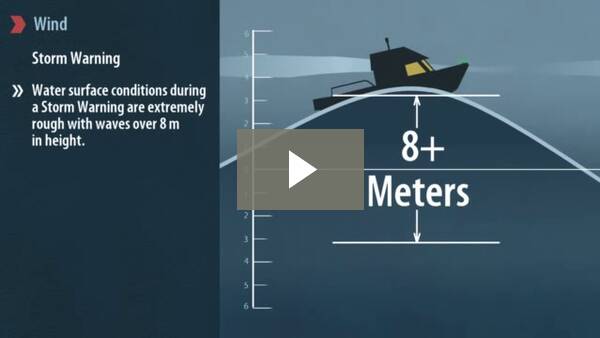Local Forecasts
Understanding weather and water conditions is vital to boating safely. You should always check the local weather forecast to obtain current, relevant information before heading out on the water. Operating your vessel without prior knowledge of potential weather hazards may put your vessel and passengers at risk. Local forecasts are available from:
- Local newspaper
- Local radio
- Television weather forecast
- Radiotelephone
- The Meteorological Service of Canada
- weatheroffice.ec.gc.ca
VHF Weather Forecasts
Environment Canada provides marine weather forecasts on the following frequencies:
Atlantic coast and Great Lakes
VHF Channel 21B, 25B and 83B
Pacific coast
VHF Channel 21B and Wx1, 2, 3
Continuous weather broadcast information is available by telephone at (604) 666-3655 (Vancouver Region)
Personal Weather Observations
In addition to checking the weather before you head out, you can use personal observations to monitor changing weather conditions:
- Keep an eye to the sky: Fog, dark clouds and lightning are obvious indications that bad weather is approaching
- Barometric readings: A rising barometer indicates fair weather, while a falling barometer indicates foul weather
- Pay particular attention to shifts in wind direction and temperature–both indicate that weather is changing
- Be mindful of the West: Foul weather usually approaches out of the west; however, storms from the east tend to be more powerful
- Be vigilant of other boaters’ movements and monitor radio and weather channels frequently–ask for recommendations via radio if in unfamiliar waters
Wind
The Meteorological Service of Canada classifies all wind speed and weather warnings in Canada. The service has identified five categories of wind conditions that are defined in terms of their wind speed and the water conditions they create. Wind speed is measured in knots–1 knot is equivalent to 1.85 km/h.
Light Winds
Light winds have a wind speed of less than 12 knots (22 km/h) and water surface conditions that are calm or have waves up to 1.5 m in height. Light wind conditions are suitable for most vessels and those operators with a moderate level of boating experience.
Moderate Winds
Moderate winds have a wind speed of 12 to 19 knots (22 to 35 km/h) and water surface conditions that are rough with waves from 1 to 3 m in height. Inexperienced operators or vessels less than 6 m in length should not operate during such conditions.
Operators of small vessels caught in a moderate winds advisory should attempt to cross waves at a 45° angle until sheltered waters are found. Ensure all passengers are wearing approved flotation devices.
Strong Winds and Small Craft Warnings
Strong winds have sustained wind speeds in the range of 20 to 33 knots (37 to 61 km/h). Water surface conditions during a strong winds advisory are very rough with waves 3 to 6 m in height. Environment Canada issues a Small Craft Warning when winds reach such levels. It is not safe to operate a pleasure craft under these conditions.
Operators of vessels caught in a strong winds advisory or small craft warning should take immediate action to ensure their safety. Turn on all navigation lights and attempt to cross waves at a 45° angle until sheltered waters are found. Reduce speed and proceed with caution, keeping a look-out for approaching boats and floating debris. If wind and wave conditions make it difficult to proceed, attempt to anchor your vessel until the storm subsides. Ensure all passengers are wearing approved flotation devices and keep passengers low in the boat and near the centreline.
Gale Warning
Gale winds have a continuous speed of 34 to 47 knots (63 to 87 km/h). Water surface conditions during a Gale Warning are extremely rough with waves 6 to 9 m in height. During such conditions, Environment Canada will issue a Gale Warning. It is not safe to operate a pleasure craft under these conditions.
Operators of vessels caught in a Gale Warning advisory should take immediate action to ensure their safety. Turn on all navigation lights and attempt to cross waves at a 45° angle until sheltered waters are found. Reduce speed and proceed with caution, keeping a look-out for approaching boats and floating debris. If wind and wave conditions make it difficult to proceed, attempt to anchor your vessel until the storm subsides.
Ensure all passengers are wearing approved flotation devices and keep passengers low in the boat and near the centreline. If your boat is taking on water, pump out bilges to keep the boat high in the water. Use an approved distress signal to signal your need for assistance if you are unable to make safe passage.
Storm Warning
Storm winds have a continuous speed of 48 to 63 knots (89 to 117 km/h). Water surface conditions during a storm warning are extremely rough with waves over 8 m in height. During such conditions, Environment Canada will issue a Storm Warning. It is not safe to operate a pleasure craft under these conditions.
Operators of vessels caught in storm warning conditions should immediately signal distress and need of assistance.








